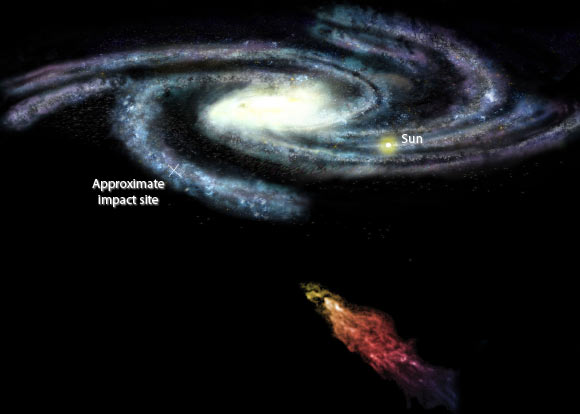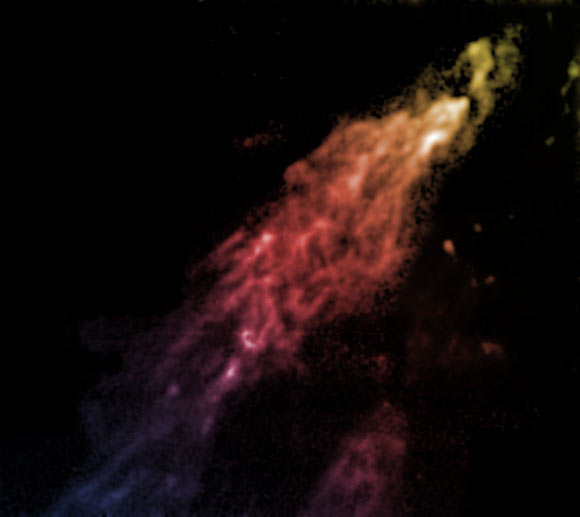Astronomers have reported the discovery of a magnetic field in the Smith Cloud, a gigantic streamer of hydrogen gas that will plunge into our Galaxy in less than 30 million years.

This is an artist’s impression of the Smith Cloud approaching our Milky Way Galaxy. Image credit: Bill Saxton / NRAO / AUI / NSF.
Discovered in 1963 by the Dutch astronomer Gail Bieger, the Smith Cloud is one of thousands of high velocity clouds flying around the outskirts of the Milky Way Galaxy.
The cloud is at least 2 million times the mass of our Sun. If it were visible to the naked eye, it would look 20 times wider than the full Moon.
Traveling at 130 km a second, the cloud is only 8,000 light-years from the Galaxy’s disk.
“Clouds like this may provide the fuel for our Galaxy to make stars. But they must be held together by something, or they’d disintegrate when they hit the warm outer part of the Galaxy – the halo. They wouldn’t reach the Galaxy’s disk, where the star-making is going on,” explained Dr Alex Hill from Australia’s Commonwealth Scientific and Industrial Research Organization, who is the lead author of a paper published in the Astrophysical Journal (arXiv.org).
Dr Hill and his colleagues from the United States have found that the Smith Cloud has a magnetic field.
“It’s 50 000 times weaker than the Earth’s, but it’s probably still strong enough to keep the cloud together,” Dr Hill said.

The Smith Cloud, imaged with the Robert C. Byrd Green Bank Telescope. Image credit: Bill Saxton / NRAO / AUI / NSF.
“This is one of the few such clouds large enough for us to be able measure its magnetic field,” added senior author Dr Naomi McClure-Griffiths, also from Australia’s Commonwealth Scientific and Industrial Research Organization.
“It seems the cloud is protected by a magnetic bubble, the same way the Earth’s magnetic field protects it from the solar wind.”
Astronomers think origins of so-called high velocity clouds are mixed, some stemming from burst bubbles in the gas of our Galaxy, some being primordial gas, and some associated with small galaxies our Galaxy’s gravity is shredding from a distance.
The Smith Cloud is probably either semi-primordial gas condensing from the halo of the Milky Way Galaxy or gas stripped from another galaxy.
The discovery also could help explain how high velocity clouds remain mostly intact during their mergers with the disks of galaxies, where they would provide fresh fuel for a new generation of stars.
______
Bibliographic information: Hill AS et al. 2013. Magnetized Gas in the Smith High Velocity Cloud. ApJ 777, 55; doi: 10.1088/0004-637X/777/1/55







